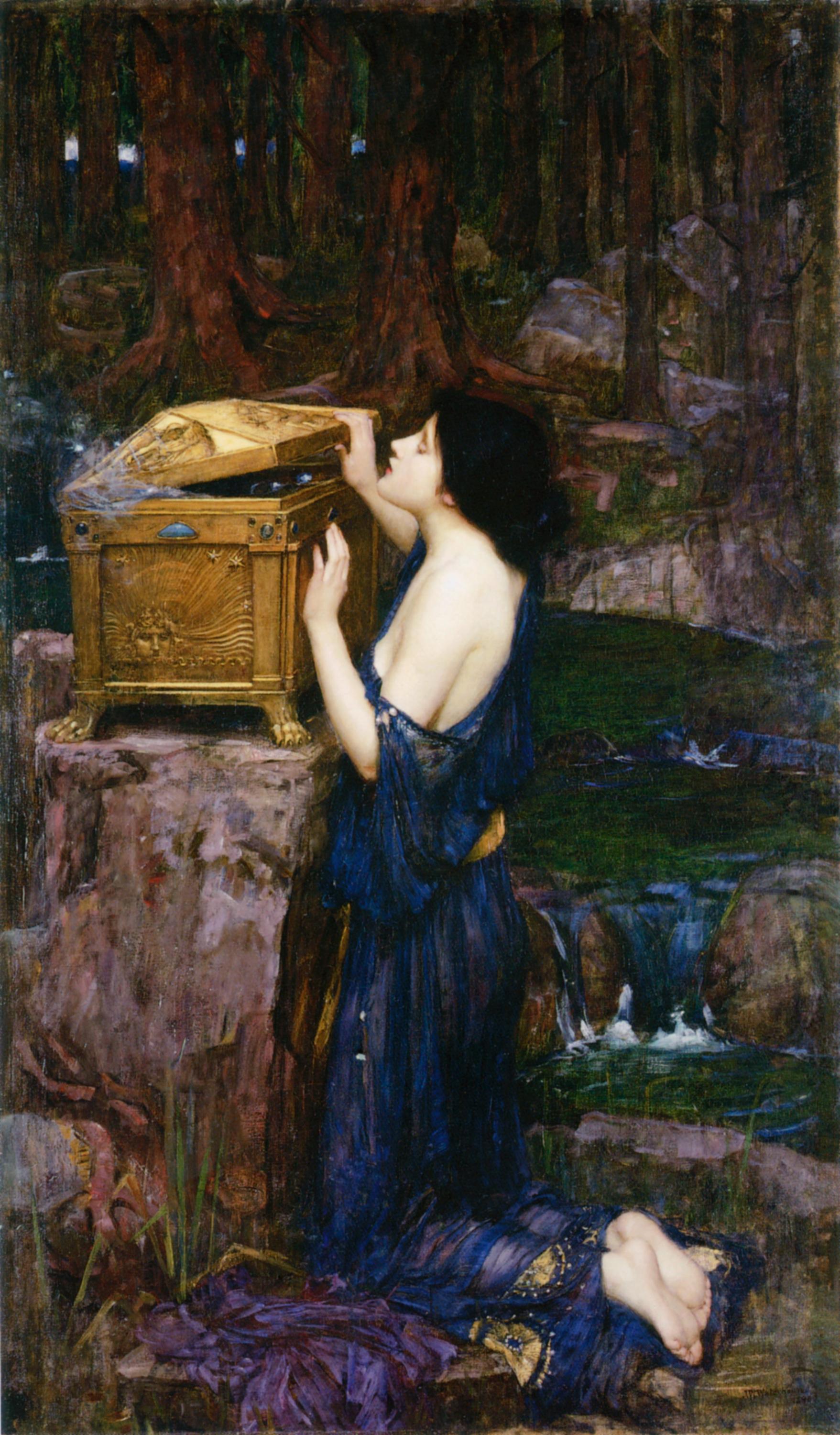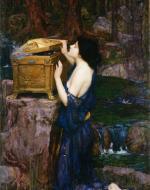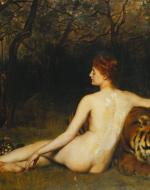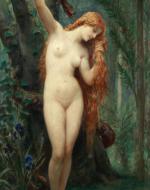Created by Savanah Green on Sat, 08/03/2024 - 13:44
Description:
Display Explanation:
Upon entering the exhibit room there is no door; the visitor walks through a curtain of green foliage crafted from vines and live plants. It hangs freely, attached at the top of the arched open doorway. The room is dimly lit with off-white, cream-colored walls. There are slightly high ceilings. The walls must be off-white not to remove from the whiteness of the women’s skin. The room is medium to large-sized (about 10m by 10m) and there is a display of hanging flowers in the center. To represent Joseph Felix Barrias' Eve, red anemone flowers, to represent John Collier's CIRCE, allium moly, for John William Waterhouse's Pandora, chrysanthemums. Each flower is threaded through a string that alternates between each flower type. Several strings hang in a wide circle chandelier and drape to the floor; the strings hang from the ceiling and are part of a circular display in the center of the room with a light installed into the wall that shines directly down into the center of the floor and centered between the flowers. The light allows for the illumination of the stringed flowers subtly, but it does not take too much attention from the paintings. My paintings are large and lack frames. They fill up about one-third of the wall. They are evenly spaced and centered on the three walls you would be facing toward upon walking into the room. The chandelier-type vines that reach the floor guide the viewer around the room; as one walks in, one must follow the path around the centerpiece before they arrive at each individual painting. This allows the viewer to consume each painting one at a time. The space between the paintings and the centerpiece permits the viewer to consume the entire painting from one spot without touching the centerpiece with their back. The floor is marble grey and white. There are three spotlights out of view, one for each painting. They are to be positioned to highlight the bodies of Pandora, Circe, and Eve. Each woman’s painting will be displayed in that order. The spotlight is to be bright enough to accentuate the women’s pale complexions, but not too wide and jarring so that the nature landscapes behind them draw too much attention from the women’s skin tones and glow. I want the viewer to see the background, so the light spans the painting but has a more centered intensity. The room is empty aside from the paintings and the centerpiece. The centerpiece not only acts as a guide, but also acts as a disruption in the room. This prevents the room from feeling fully empty and removes the sense of cleanliness and purity in a bare white room. In the background, I'd like In the Forest M. K. Čiurlionis and other similar-sounding pieces to play to fully evoke a natural, foresty vibe with some sense of impending doom or tenseness which interrupts the peacefulness of nature sounds.
The foliage curtain is to set a tone of exoticism. I want the viewer to feel as though they have just entered a jungle, but upon fully entering the room they are hit with a majority white or cream presentation as opposed to a room fully engulfed by nature. I still wanted to incorporate a centerpiece into the room that matched the theme while guiding the viewers in the direction they needed to go in. I carefully selected each type of flower. Each woman’s flower represents something relevant to their story or biblical/mythological context. For Eve, I chose red anemones, as they often represent the blood shed upon Jesus’ crucifixion as well as represent forsaken love. Today, they are known as a symbol of love. For Eve, this means giving into temptation or rather rejecting the love of God. She is one of the figureheads of sin for humanity. For the viewer, with context, Eve is to be viewed as a sinner, yet Barrias depicts her as pure (which is seen through her skin), vain, and possibly curious, as she is viewing her reflection or observing the water. She knows she is tempting yet deceives the viewer with her innocent look. The serpent is a warning sign of her deceit and of what is to come. Pandora’s flower is a chrysanthemum, which in Europe is used at funerals or given to grieving families or individuals. They are seen as a protector against evil spirits in Greek mythology. I chose these flowers to represent the incoming evil Pandora is going to unleash upon the world. For Circe, I chose allium moly. In the Odyssey, Odysseus uses these flowers as an antidote against Circe’s drugs. I selected these to suggest resistance against her temptations. This was used to counteract her induced hallucinations. In terms of her sexuality, her body on display is the “hallucination” and these flowers are the antidote the viewer should have at their disposal in the display room. In the background of her painting, you can see the swine who were tempted by her already. I chose the order of the paintings to start with Pandora, as she released evils upon the world and depending on the version of her story you read, was arguably innocent. She was created to be beautiful and enticing but also given extreme curiosity alongside her box. I do not want to neglect the fact that she was given free will though and had the power to not open the box. Then we move to Circe, I centered her partly due to the horizontal nature of her painting, but also to emphasize she is the most outwardly manipulative. Circe is feared by many and turns trespassers into swine. Once again, depending on the interpretation of her mythos you read, she is doing this for her protection. In many versions, she is a temptress or a seductress and is very manipulative. Finally, I left Eve as the last painting, for her story is another story of the release of sin. Eve is either curious or distracted by her reflection in the water beneath her. Behind her is the snake who manipulates her, yet she is too naive to realize. Both Eve and Pandora were arguably manipulated into their course of action. Circe, her pose and painting are different, so I centered her to emphasize this difference.
Installation Note:
This exhibit is meant to draw on society’s infatuation with purity and how a woman’s sense of innocence is transformed into sex appeal. In literature, media, artwork, and other forms of art, women are often drawn and depicted in ways that appeal to the male gaze yet are also portrayed as temptresses who are out to seduce and manipulate men (hence my installation title which utilizes the term “femme fatale”). The art pieces in this installation are excellent examples of this narrative. Eve and Circe are depicted with red hair, an indication of sensuality, and pale skin associated with purity, attractiveness for their time, and cleanliness. Pandora has dark hair, lacking the sensual feel, yet her skin is arguably the whitest of the women depicted in the three paintings. The perspective or gaze of the viewer for both Circe and Pandora almost feels as if we are peering in on something we shouldn’t see, but also elicits curiosity, as we are wondering what these women are looking at. Their beauty, nudity, and unnatural poses are all symptoms of the male gaze. Circe, on the other hand, seems to know she is being viewed. Her pose feels more powerful and in charge. Each woman’s background portrays them in nature and portrays both beauty and savagery, as there are predators in both Circe and Eve’s environment. Their bright skin and beauty initially overshadow the dangers. Their sexuality is dangerous and powerful when used to their own advantage.
These women known for their deceitfulness and unfaithfulness as well as their ability to feign purity and ignorance to their situations. Despite the clear warning signs in the paintings, the snake, the vanity of staring at your own reflection, and the swine that blend subtly into Circe’s landscape, the viewer’s eyes are drawn to the beautiful, naked bright women who are there to seduce you. Circe specifically uses her self-awareness regarding her beauty to her advantage (her seductive pose). These views of the women’s character are yet again more symptoms of the male gaze. Each painting contains a “predator” or threat. Each woman is ultimately working with or influenced by what is in her environment. For Pandora, it is her box. For Eve, it is the serpent. For Circe, it is her tigers. These threats are posed next to or near each woman to emphasize the fatality surrounding them. Or, maybe it is to distract the viewer from the true threat of each woman. We are initially afraid of the natural world (or the supernatural world in the case of Pandora), but the true horror is the woman who is concealing her deceit and true intentions through sex appeal. The use of the natural world and environment in these paintings also hints at their animalistic and cunning cruelty. They are yet another predator you may find in the woods. The difference for Circe is that even the tigers nuzzled up to her may be victims of her sorcery. The swine in the background provides the most warning for her viewers, but her power and ability to transform human beings and other creatures into animals are not limited to swine. For Pandora, we do not see the man she betrayed and she is more clothed which makes her feel more reserved or innocent. She does not tell her husband she is opening the box though, so she is still deemed responsible for leading to man’s downfall. She deceives those around her. Eve, she is blamed for leading Adam astray although God gave both Adam and Eve the same warning against the fruit. These women’s sexuality, purity, and temptation are their power, but man's downfall.
Work's Cited:
Barrias, Felix Joseph. Eve. 1877. https://www.art.salon/artwork/felix-joseph-barrias_eve_AID476423. Accessed 16 Feb 2024.
Collier, John. CIRCE. 1885. https://en.m.wikipedia.org/wiki/File:CIRCE,_John_Collier_1885_-_Ger_Eene...Accessed 16 Feb 2024.
Waterhouse, John William. Pandora. 1896. https://en.wikipedia.org/wiki/John_William_Waterhouse#/media/File:John_W.... Accessed 16 Feb 2024.
Copyright:
Associated Place(s)
Featured in Exhibit:
Artist:
- Multiple Artists




